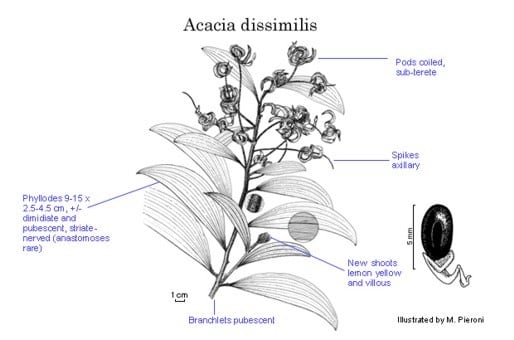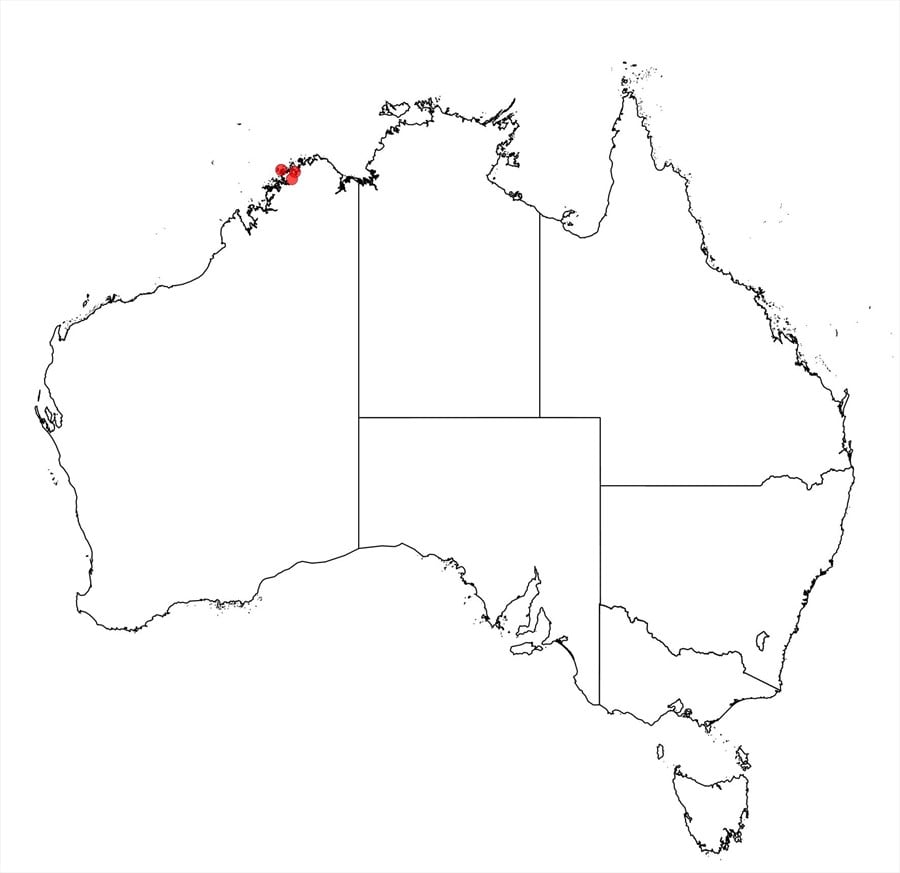Acacia dissimilis M.W.McDonald
WATTLE
Acacias of Australia
Common Name
Mitchell Plateau Wattle
Family
Fabaceae
Distribution
Known from only two sites in the northern Kimberley region, W.A., namely, the Mitchell Plateau (where it grows on laterite) and Laplace Is. (where it has been recorded from near the summit of the island, on basalt).
Description
Openly branched shrub to 2.5 m high. Bark smooth, grey. New shoots villous, hairs lemon yellow. Branchlets terete except slightly flattened at extremities, sparsely to densely silvery pubescent. Stipules 4–5 mm long. Phyllodes dimidiate or slightly subfalcate, sometimes with shallowly recurved apices, 9–15 cm long, 2.5–4.5 cm wide, thinly coriaceous, sparsely to moderately sericeous, grey green; longitudinal nerves numerous and parallel (nerves 6–7 per mm and with broad internerve spaces between them), anastomoses rare, 3–7 main nerves more evident than the rest; pulvinus 5–10 mm long, hairy, brown. Inflorescences simple, 2 per axil; peduncles 8–10 mm long, densely hairy. Flowers not seen but fruiting receptacle of spike to 8 cm long. Pods linear, sometimes slightly constricted between the seeds, sub-terete to slightly flattened, coiled, sometimes twisted, 2–7 mm wide, crustaceous, sparsely pubescent, longitudinally wrinkled. Seeds ±longitudinal, elliptic to irregularly ovate, 3–4 mm long, 2–3 mm wide, glossy, black; funicle/aril twice-folded, cream.
Specimens
W.A.: Amax base camp, Mitchell Plateau, West Kimberley, K.F.Kenneally 6799 (PERTH); Laplace Is., K.F.Kenneally 11229 (PERTH).
Notes
Acacia dissimilis is seemingly a member of the ‘A. tumida group’ but distinguished from all other members by its lemon yellow, villous new shoots and its coiled pods with small seeds; it is also distinctive on account of having hairy branchlets, phyllodes and pods. Its phyllode nervature is similar to that of A. tumida but its simple axillary inflorescences suggest affinities with A. brassii, fide M.W.McDonald, Austral. Syst. Bot. 16: 149 (2003).
FOA Reference
Data derived from Flora of Australia Volumes 11A (2001), 11B (2001) and 12 (1998), products of ABRS, ©Commonwealth of Australia
Author
B.R.Maslin, M.W.McDonald
This identification key and fact sheets are available as a mobile application:
URL: https://apps.lucidcentral.org/wattle/
© Copyright 2018. All rights reserved.







